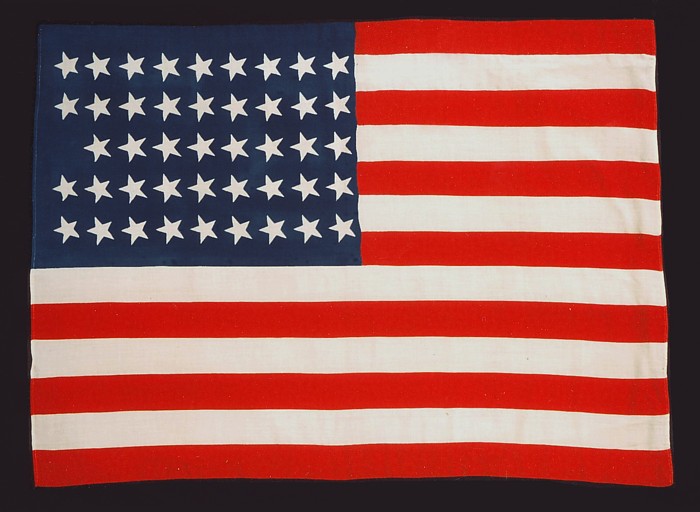
| |
44 STARS, WYOMING STATEHOOD, 1890-1896, NOTCHED CONFIGURATION w/ ROWS OF 9 STARS |
|
| Available: |
Sold |
| Frame Size (H x L): |
n/a |
| Flag Size (H x L): |
44" x 55" |
|
| Description....: |
|
44 STARS, WYOMING STATEHOOD, 1890-1896,
NOTCHED CONFIGURATION WITH ROWS OF 9 STARS,
AN UNUSUAL PRESS-DYED EXAMPLE:
44 star American national flag, press-dyed on very fine wool or a wool and silk blended fabric. This particular wool is highly unusual in flag-making, and though I have seen similarly odd fabrics used in press-dyed and printed flags, there is only one other flag that I can recall handling with the same exact fabric, another 44 star flag in the same pattern, in a similar size, probably from the same manufacturer.
The stars, which all point to the 11:00 position, are arranged in a notched pattern, which indicates that the maker suspected the forthcoming addition of another Western Territory (in this case, Utah). Leaving an open space for a star would make re-designing the print block far easier and thus more cost effective, though it is interesting to note that I have never seen an example of this flag with the 45th star added.
Another unusual trait with regard to the stars is the fact that there are 9 stars in four of the rows. Flags almost never used rows of 9 or 10 stars, and while counts this high obviously exist, they are very rare. Flags with rows of stars had rows of 8, 7, 6, and sometimes 5 stars, generally not more or fewer with the exception of 13 star flags, which commonly used rows of 4, 3, and 2 stars. Note how the impact of the flag's design is greatly influenced by its squarish proportions, and how the use of rows of 9 stars on a flag with so short a length causes the canton to take up slightly greater than half of that length. The flag's color also lends to its appeal, as the blue is even stronger that it appears in the photos.
The press-dyeing process was patented in the U.S. in 1849. In regard to wool flags, the process was primarily used during the Centennial-era by the U.S. Bunting Company of Lowell, Mass, which began making press-dyed flags for the U.S. military in 1869. The U.S. Bunting Co. was one of the first firms to successfully produce high quality wool bunting in the States, and while its owners worked diligently to master the press-dyeing process, it was very expensive and never become a popular method of flag production.
It is likely that this particular flag was made for military use. Infantry and Cavalry had quite consistently carried silk flags throughout our nation's history for several reasons. Silk was extremely light weight. Stars could be painted on instead of sewn for further weight reduction, and fanciful designs such as crests could be painted on as well. Silk had less water absorption than cotton, but wool was even better. Wool was heavy, however. The ability to print on this fine wool could have been perceived as a further evolution in the production of light weight, water-shedding, military flags, most of which had a shape that was nearer to square, like this example. But for one reason or another, use of this manner of construction never took hold.
The 44th state, Wyoming, gained statehood on July 10th, 1890. Many flag makers would have began to add a 44th star to their flags on or before that day, and the 44 star flag would have generally seen use until the addition of Utah in 1896.
Mounting: The flag has been hand-stitched to 100% cotton, black in color, but has not yet been mounted.
Condition: There is very minor mothing, but there are no significant condition issues. |
|
|
|
| Collector Level: |
Intermediate-Level Collectors and Special Gifts |
|
| Flag Type: |
Sewn flag |
|
| Star Count: |
44 |
|
| Earliest Date of Origin: |
1890 |
|
| Latest Date of Origin: |
1896 |
|
| State/Affiliation: |
Wyoming |
|
| War Association: |
1866-1889 Indian Wars |
|
| Price: |
Sold |
|
| |
Views: 2980 |
|
|
|

